Part Five in new News-Press series
By PETER LANCE, SPECIAL TO THE NEWS-PRESS
October 7, 2012 10:05 AM Fifth of five parts
April 22, 2011, was Good Friday. Until that day, a 34-year-old Santa Barbara woman was a licensed insurance broker. She came from a solidly middle-class law enforcement family. Not only did her mother work for the county helping to enforce the child support laws, but her brother had been a CHP officer killed in the line of duty.
The woman never fully recovered from that loss, and after work on Good Friday, she stopped at several bars. By 7 p.m., she was clearly impaired. Mistakenly thinking that she had to pick up her son at school, she drove there only to clip an oncoming car as she turned into the parking lot.
There is no dispute that the woman was driving under the influence — and after a field sobriety test by Officer Kasi Beutel, she was arrested, cuffed and in the back of a patrol car heading to County Jail.
But it wasn’t the DUI collar that changed this woman’s life. What cost her her job, subjected her to disgrace among her associates and has rendered her out-of-work ever since was the additional charge of possession of a controlled substance, heroin.
OFFICER BEUTEL’S VERSION OF EVENTS
In her arrest narrative, Officer Beutel wrote, “On 4/22/11 at approximately 1905 hours I was dispatched to a traffic collision at Mission and Laguna. Officer Bedolla and Officer Epstein arrived on scene prior to me. I arrived and contacted Officer Bedolla who was standing by with (the woman) … Bedolla stated that (the woman) was showing objective symptoms of intoxication and requested I assist with a DUl investigation.”
Officer Beutel noted the woman had bloodshot, watery, droopy eyes and a slack face. She asked whether the woman remembered what happened and the woman stated that she was turning into the parking lot when she collided with the other car.
“I asked her if she had any injuries or if she had been wearing her seatbelt,” the officer wrote in her narrative. “She stated she was not injured and didn’t understand why she was getting ‘the third degree.'”
SCREAMING TO BLOW HARDER
In an interview for this story, the woman told me that when she challenged Officer Beutel, the award-winning DUI officer got angry.
“She was giving me a very hard time. When she gave me the breath test she was screaming at the top of her lungs for me to blow harder, blow harder. So I gave it right back to her.”
In this case Officer Beutel’s behavior was consistent with what I’d experienced myself when she arrived to investigate me for a possible DUI on New Year’s Day 2011. When I casually joked that she must have a quota, the officer flashed anger and immediately put me in handcuffs, threatening to send me to jail if I didn’t shut up.
All charges were dropped against me on Nov. 15, 2011, and the Department of Motor Vehicles restored my driving privileges in March of this year. But the admonition to “blow harder, blow harder,” which Officer Beutel yelled during my Breathalyzer test, was virtually identical to the accounts of multiple Beutel DUI arrestees I later interviewed.
Several noted that when they had challenged Officer Beutel she escalated her behavior.
THE DUI ARREST
Continuing with the arrest narrative from the night of April 22, 2011, Officer Beutel wrote that, after a series of field sobriety tests, she placed the woman under arrest on suspicion of DUl and “informally advised her of implied consent.” This last part means she had given the woman the option of taking a blood test.
According to Officer Beutel’s written account, “She initially just stated that she would not do a blood test. After the EPAS (Breathalyzer) was ready (the woman) completed 1 breath test which registered .22 BAC, however when I attempted to have her complete the second test she refused.
“I placed her in the rear of my patrol vehicle and transported her to County Jail where Lesser Michaels (the blood technician) performed an evidentiary blood test which I witnessed and packaged and placed in the DOJ depository.”
But that was a misstatement of fact. All Mr. Michaels did was draw a sample of blood. No analysis was done at the jail, contrary to Officer Beutel’s report of an “evidentiary test.” Further, what she didn’t write is that the blood draw took place after the following events, which she chronicled in detail:
CLAIMING SHE OBSERVED THE HEROIN DROP
“As (the woman) was being booked into County jail Officer Dominick of the SBSO was searching her. Officer Dominick (a custody deputy at the jail) removed (the woman’s) jacket and a small black plastic baggie with a brown tar like substance which was consistent with black tar heroin fell to the ground at (the woman’s) feet. Officer Dominick picked up the substance and handed it to me.”
When I interviewed the woman in the presence of her mother, she said that she was “shocked” when the custody deputy picked up the bindle. “That was not something that I would ever expect to be on me or near me,” she insisted.
Her mother told me that they had a family friend named Bobby who had nearly died of a drug overdose.
“She called me from jail,” said her mother. “She told me she was stunned about the heroin that they would even think it was hers. And she started crying and saying, ‘You know I’d never use heroin because of what happened to Bobby.’ Not to mention her brother, who was as straight an officer as they come. She was in utter shock.”
The woman said that she later asked the blood tech if the sample he’d drawn was going to be tested for heroin, but he told her no.
In the arrest narrative, Officer Beutel wrote that the woman “refused to speak about the bindle except to say that she did not currently have any heroin in her system.”
While avoiding any discussion of what type of test was ordered for the blood, the officer went on to write, “The heroin was field tested at the SBPD and tested positive for heroin. It has been booked at the SBPD.”
In addition to the DUI allegation, Officer Beutel noted that the woman was booked on suspicion of possession of a controlled substance.
Because of the seriousness of the possession charge, bail was set at $10,000, but as a first offender the woman was released on her own recognizance.
SEARCHING FOR THE TRUTH
Eventually, after word about the alleged heroin possession got out, the woman was fired from her job. “It was devastating,” she said. “I couldn’t face my friends or my co-workers even though it was an absolute lie.”
She hired Santa Barbara DUI defense attorney William Makler, who had several Kasi Beutel cases pending. Mr. Makler was immediately skeptical.
“I knew that Beutel’s credibility was highly questionable,” says Mr. Makler. “But the DA was taking a very hard position. At one point they even threatened to charge my client with possession with intent to sell, which is a serious felony.”
On top of that, at the end of the arrest narrative, Officer Beutel wrote: “Please forward a copy of this report to the District Attorney’s Office for review and filing of the aforementioned charges. Additionally please review for 4573 PC, bringing controlled substances into jail.”
THREATENING AN ADDITIONAL FOUR YEARS
While “simple possession” under the state Health & Safety Code carries a maximum sentence of $1,000 fine for a first offender, the additional charge that Officer Beutel recommended — Section 4573 of the California Penal Code — is a serious felony. The intent of the law is to prevent the intentional smuggling of drugs into a jail or prison. Violations are punishable by up to four years.
“The idea that Kasi Beutel would go so far as to suggest upping the charges against (my client) by using a law designed to stop smuggling was outrageous,” says Mr. Makler. “Even if by argument my client had the substance on her — and she clearly didn’t — she certainly had no idea she was going to be arrested and thus lacked any intent to bring drugs into jail.
“That suggestion by Officer Beutel that (my client) be charged with smuggling, along with my client’s absolute insistence that she had never even seen the heroin before the booking, much less possessed it, was what caused me to go to the next step. So I requested a copy of the jail video from the night of the booking.”
What Mr. Makler found in that video was startling.
EVIDENCE OF KASI BEUTEL PLANTING OF BLACK TAR BINDLE
A series of still shots taken from the jail video, show Mr. Makler’s client in a purple tank top and blue jeans being processed by two Santa Barbara County Sheriff’s Department custody deputies: a female (Officer Dominick) standing behind her and conducting the search of her clothing and a male (Officer Torres) to her right. Officer Beutel can be seen standing in the immediate vicinity. The video has a time code reflected at the bottom of each still. 
As the video shows, for unknown reasons, Officer Beutel selected six rubber gloves from a box, then dropped one or more of them and squatted down within inches of the suspect’s feet. She then tossed the glove or gloves in the precise direction where the heroin bindle was later found, affording her the perfect opportunity to cover the planting of the bindle with the glove drop.
That is circumstantial and clearly not definitive. However, the most telling aspect of Officer Beutel’s intent comes in her own words from the arrest narrative which is reproduced below with the suspect’s name redacted: 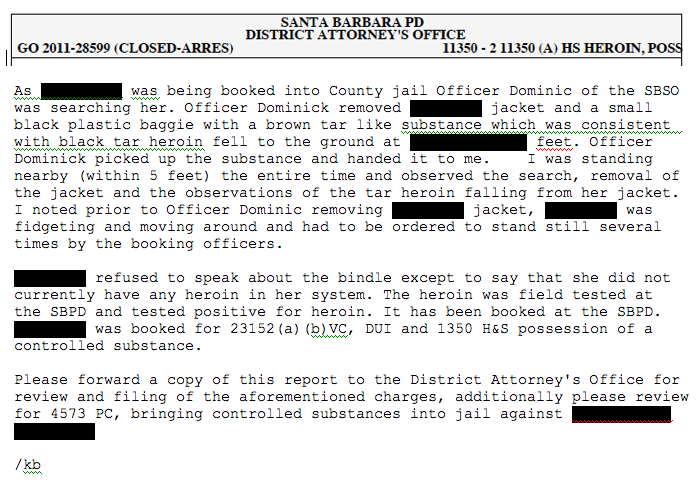
“Clearly the stills from the video prove that Officer Beutel is misstating the facts,” says the suspect’s attorney Mr. Makler. “Not only was there no ‘aha moment,’ where the bindle fell from the hoodie as it was being shaken, but Kasi Beutel was facing in the opposite direction when Officer Dominick looked down and spotted it on the mat by the counter.
“The fact that Beutel would include such an affirmative misstatement in her police report,” says Mr. Makler, “is compelling proof of mens rea or a guilty mind on her part. Why offer a detail like that, saying she ‘observed the search’ and ‘the tar heroin falling from her jacket,’ when she didn’t?”
BEUTEL FAILS TO ORDER TEST FOR HEROIN
As Officer Beutel noted in the narrative, the woman’s blood was drawn at the jail by Lesser Michaels, the blood tech who works for the District Attorney’s Office. It was then sent on for testing by the state Department of Justice lab in Goleta. But for unknown reasons, the initial test ordered by Officer Beutel was for the presence of alcohol only. She never asked that the blood be tested for opiates, which would have detected any heroin.
The blood was tested three days later and showed a blood alcohol content of .27 — higher than the .22 BAC Officer Beutel had registered on the Breathalyzer in the field.
RESULTS OF A SECOND TEST 10 MONTHS LATER
The blood draw is the only test in a DUI investigation where the evidence can be re-tested, and on March 2, 2012, after he’d seen the jail video, Mr. Makler had the sample of his client’s blood tested again by the Department of Justice in Sacramento. The results: At the time of the arrest, his client’s blood was negative for any opiates — the classification for heroin.
“Heroin is highly addictive drug,” says Mr. Makler, “and black tar heroin, which is injected or smoked, is among the most addictive forms. Certainly if my client was a user and had the drug in her possession, there would have been evidence of it in her blood. But we went way beyond the blood test to prove she was innocent of the possession charge.”
DNA HAIR TESTS PROVE ZERO HEROIN
On Jan. 30, the woman freely offered samples of her hair for DNA toxicology analysis at Pacific Toxicology Laboratories in Chatsworth. Hair segments underwent a DNA test in increments of three months going back to one year prior to the test.
The hair was screened for the presence of opiates, amphetamines, cocaine, marijuana and PCP (angel dust), the most common substances used by drug abusers. The test proved that she was 100 percent drug-free — not just on the night Kasi Beutel recounted the “observations of the tar heroin falling from her jacket,” but for the three months prior and the nine months since.
PASSING A POLYGRAPH TEST
Mr. Makler was so convinced of his client’s innocence when it came to the heroin possession charge that along with defense attorney Darryl Genis he commissioned a polygraph test for her. As a measure of her own confidence that she’d never used heroin or had it in her possession, the woman freely submitted to the test by polygrapher Henry Stewart on May 30. The examination was conducted using the Lafayette Instrument Polygraph System LX-4000. These are the results of the two most important questions he asked her:
•”Did you knowingly bring heroin into the Santa Barbara jail?” Her answer was “No.” And the test proved that she was telling the truth: Her response was “non-deceptive.”
•”Regarding the blood test, did you ask if the blood would be tested for heroin? Her answer was “Yes.” Again, the polygraph showed she was being honest — “non-deceptive.”
WHY WASN’T HEROIN FOUND IN PAT-DOWN?
Section 902.4 of the Santa Barbara Police Department manual requires that “any person taken into custody may be subjected to pat-down searches … and thorough clothing searches in order to discover and retrieve concealed weapons or contraband.”
“That’s police work 101,” says Felix D’Amico, a former sergeant with the San Bernardino Sheriff’s Department who conducted or observed more than 5,000 DUI arrests in his career. “When you arrest someone, you just don’t do a pat-down, you search them thoroughly, including all their pockets, for weapons or contraband. That happens before you take them into a jail system. If this woman was holding (drugs), any cop worth their badge would have found the bindle of heroin, especially, if, as Officer Beutel suggests, it was in (the jacket) and just fell to the floor when it was shaken out. So you have to ask, why didn’t Officer Beutel find it in the street before bringing her into the jail?”
HOW DID IT GET THERE?
Would law enforcement go to the extreme of planting drugs on a suspect who was intoxicated and, ultimately found guilty of a DUI offense, but otherwise innocent?
Santa Barbara County Sheriff Bill Brown told the News-Press that upon looking into a bindle of heroin inexplicably winding up on the floor of one his facilities his staff was in the clear.
“After the existence of this video tape was brought to my attention, in connection with allegations of misconduct by an officer that stemmed from a booking in the Santa Barbara County Jail, I reviewed the tape to determine if there was any issue involving a member of the Santa Barbara County Sheriff’s Office,” he said. “Upon review it does not appear there was any inappropriate action by any member of the Santa Barbara County Sheriff’s Office.”
So if the custody deputies had nothing to do with it, and the DUI suspect says she had nothing to do with it, how did the heroin get on the floor of County Jail?
Could Officer Beutel have been involved?
“Any questions you may have regarding the actions of a member of another law enforcement agency should be directed to that agency,” said the sheriff.
Even the DA’s office, which also viewed the video, is baffled.
“The video itself makes it difficult to draw any definitive conclusions regarding where the bindle actually came from,” Lee Carter, the senior deputy district attorney who filed the charges, told the News-Press in an email.
EVENTS LEADING UP TO THE HEROIN DISCOVERY
Something happened earlier in the day on that Good Friday that, according to Darryl Genis, my attorney, might have empowered Officer Beutel “to think she was a law unto herself.”
April 22, 2011, happened to be the date of a hearing in my DUI case before Judge George Eskin, a former assistant district attorney in Santa Barbara County. As detailed in my original series, Judge Eskin, later removed himself from my case after I filed a motion alleging bias, a claim he denied.
But during the period when he was still presiding over my case, Judge Eskin conducted a pretrial hearing in Dept. 12 of Santa Barbara County Superior Court, at which Officer Beutel was present along with Officer Mark Corbett, who had preceded her as lead officer in the Drinking Driver Team. At that time the couple were engaged to be married (and since have wed).
The principal subject of the hearing was whether Officer Beutel should be ordered to testify under oath as to the actual number of DUI arrests that led to her getting the 2009 MADD award for DUI collars.
My preliminary investigation revealed that Officer Beutel had exaggerated her arrest record, and since her credibility was a central issue in my case, Mr. Genis was anxious to get her on the stand to discuss how she came up with the total of 331 arrests that earned her the MADD award. That figure was almost three times as high as the next officer in the department.
Earlier on April 8, during an in camera session in his chambers, Judge Eskin had referred to Officer Beutel as an “exemplary officer.” Now, at this hearing on April 22, he not only questioned my motives for challenging Officer Beutel’s arrest record, he refused to put her under oath. This is a portion of the transcript, which includes comments by Mr. Genis and the prosecutor, Deputy District Attorney Sanford Horowitz:
Judge Eskin: I don’t think Officer Beutel is the witness to be called.
Mr. Horowitz: I don’t either.
Mr. Genis: Your Honor, she’s the person who supposedly made these arrests.
Judge Eskin: According to whom?
Mr. Genis: Until I put her on the stand, I don’t know.
Judge Eskin: You’re fishing. You’re fishing.
Mr. Genis: No. I’m absolutely not. I am attempting to prevent a situation where Officer Beutel attempts to get on the stand and says whatever she wants and I can’t cross-examine her about it … My question to you is, would Officer Beutel accept the 2009 MADD award for 331 arrests if she knew that she had not made that number of arrests? And if your answer to that is that she wouldn’t … then why wouldn’t you let me put her on the stand to ask her if she made 331 arrests in 2009 under oath?
Judge Eskin: I think it’s irrelevant … And all I’m involved in is the prosecution of a case involving a .09 blood alcohol level and I’m going to try and control it. I haven’t done a good job, as I said. But I’m not going to let this court be used as a vehicle for Mr. Lance to pursue his agenda … His agenda in this courtroom is to prove beyond a reasonable doubt that ‘I was not under the influence of alcohol.’ That’s his agenda. And it should be your agenda. Not the attempt to destroy the career of Officer Kasi Beutel.
Mr. Genis: I’m not trying to destroy anybody’s career.
Judge Eskin: Nobody could read these pleadings and not come to that conclusion… You have not made one — provided me with one scintilla of evidence — that Kasi Beutel went around telling people that ‘I made 331 arrests last year.’ Not one piece of evidence. Not one fact.”
The judge denied our request to put Officer Beutel on the stand to determine whether she was the source of the 331-arrests figure. Then, four days later, we got the answer pursuant to the California Public Records Act: On April 26, the Santa Barbara Police Department turned over an email dated Jan. 5, 2010, from Officer Beutel to the California Highway Patrol in response to an earlier request for MADD nominations. In it, she wrote, “Stats for the annual MADD Awards for 2009. Officer Klug: 111 Officer Beutel: 331.”
Not only did Judge Eskin shield Officer Beutel at that second hearing, but it took us another six months before we could get her under oath, during which, as documented in yesterday’s installment, she twice avoided subpoenas to appear at the DMV after two SBPD lieutenants swore that she was too sick to testify.
HEROIN CHARGES GO AWAY
The woman’s case wound its way through the judicial system, with 15 court appearances over the next 11 months. It was only on March 28 of this year, when confronted with the jail video and the blood and DNA test results showing that the woman had been heroin free, that a colleague of Mr. Carter’s agreed to dismiss the heroin possession charge along with a second DUI count. The woman ultimately pleaded guilty to a single count of driving under the influence and was sentenced to two days in jail, a fine of nearly $1,900 and three years probation.
OFFICER BEUTEL’S SIDE OF THE STORY
On Sept. 3, 2012, I sent Officer Beutel a series of questions via email, including:
•If you searched the woman in the field after her arrest, why didn’t you find the bindle of black tar heroin?
•If you contend that the woman brought the heroin into County Jail, why didn’t you order her blood tested for the presence of opiates?
•Did you plant that bindle of black tar heroin?
Officer Beutel has not replied.
But it wasn’t the first time that Officer Beutel had been asked a question like that. As recently as May 17, 2012, as she was on the stand before Santa Barbara County Superior Court Judge Brian Hill, being cross-examined by Mr. Genis during the prosecution of another of his clients, Valerie Moreno, this exchange took place between Mr. Genis, Deputy District Attorney Justin Greene and the judge:
Mr. Genis: (to Officer Beutel) Is it fair to say you never planted heroin on Ms. Moreno in jail?
Mr. Greene: Objection.
Judge Hill: Sustained.
Mr. Genis: Have you ever done that to anyone else?
Mr. Greene: Objection. Argumentative.
Judge Hill: Sustained.
Mr. Greene: Relevance.
Judge Hill: Sustained.
COMING FULL CIRCLE ON RELEVANCE
We began this five-part series with a discussion of the charges now facing Los Angeles Police Department DUI officers Craig Allen and Phillip Walters who were indicted by the Los Angeles County District Attorney’s Office in July after they allegedly committed perjury and filed a false report in a single DUI case.
In last summer’s series, we described the case of Sacramento DUI Officer Brandon Mullock who lied on a series of police reports causing 79 cases to be dismissed. In San Diego, Officer Thomas Broxterman was removed from the DUI task force after it was determined he’d falsified numerous investigative reports.
According to federal court pleadings filed in April of this year, after returning to DUI enforcement, Officer Broxterman effected a false arrest and fabricated reports, only to get sued in U.S. District Court by a DUI arrestee who was awarded money damages.
But the problem isn’t unique to California. In Charlotte, N.C., after a dash-cam video contradicted the testimony of DUI Officer Barry Grimes, he was held in contempt of court and ordered jailed for 30 days, jeopardizing up to 100 of his other DUI cases. On Aug. 13, four Honolulu, Hawaii, officers were charged with falsifying DUI arrest reports so that fellow officers who weren’t present would qualify for possible overtime. The two sergeants and two patrol officers charged were part of a DUI checkpoint task force known as the Night Enforcement Unit.
A week later, the city of Chicago settled the last of a series of federal civil rights cases involving former MADD award winner Officer Richard Fiorito, who was pulled off the street in 2009 amid charges he falsified dozens of charges against DUI suspects.
The settlement with just two of Officer Fiorito’s many arrestees came on the eve of trial. Amid a series of lawsuits, the Cook County State’s Attorney’s Office dropped charges against more than 130 drivers arrested by Officer Fiorito, according to The Chicago Tribune.
The ultimate question for Santa Barbara County District Attorney Joyce Dudley, is whether she will apply the same rigorous standards to Officer Kasi Beutel that L.A. County District Attorney Steve Cooley applied to officers Allen and Walters; and if she doesn’t, will California Attorney General Kamala Harris step in and appoint a special prosecutor to get to the bottom of “Kasi-gate?”
We asked Mr. Carter whether the discrepancies in Officer Beutel’s version of the heroin “find” and the video of the incident factored into the District Attorney’s Office decision to drop the most serious allegations.
His response: “The filing and disposition of this case, as with all cases, was based upon the entirety of the admissible evidence, our ability to prove each charge to the standard of beyond a reasonable doubt, and justice.” Copyright 2012 By Peter Lance


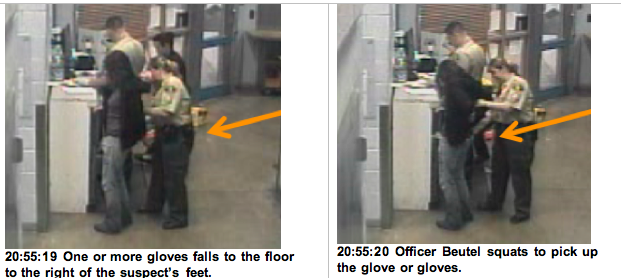
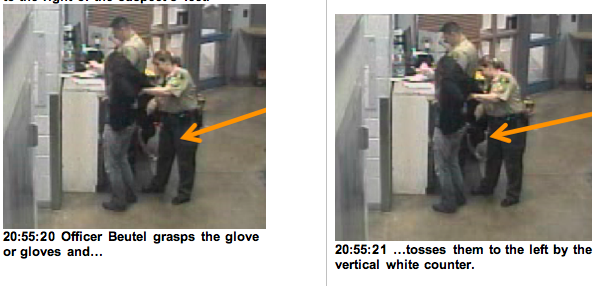
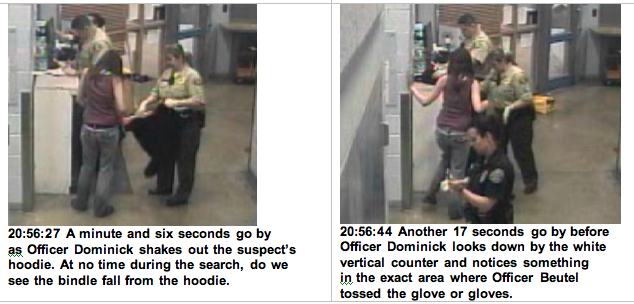
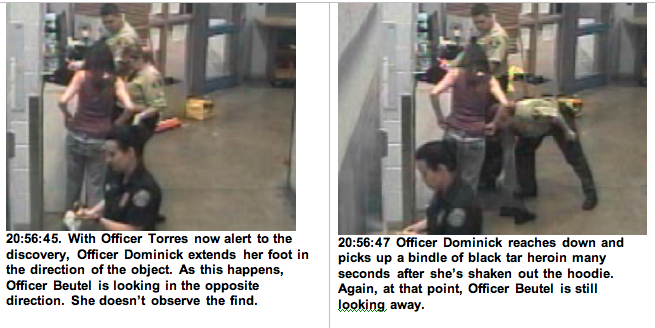

Recent Comments